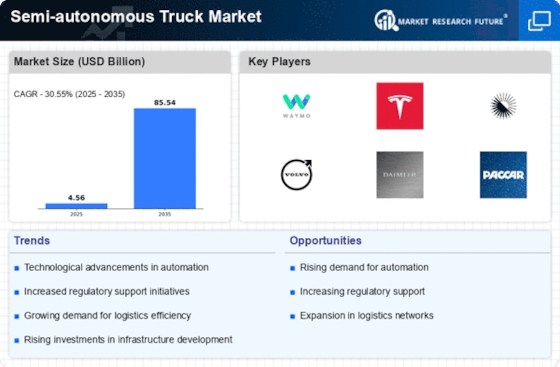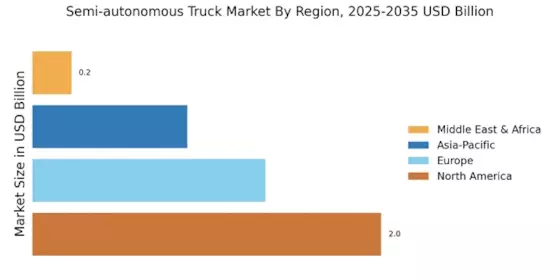Regulatory Support and Incentives
The Semi-autonomous Truck Market is benefiting from increasing regulatory support and incentives aimed at promoting advanced vehicle technologies. Governments are recognizing the potential of semi-autonomous trucks to enhance road safety and efficiency. As a result, various initiatives are being introduced to encourage the adoption of these technologies. For instance, tax incentives and grants for companies investing in semi-autonomous technology are becoming more common. This regulatory support is likely to accelerate the integration of semi-autonomous trucks into existing fleets, fostering market growth. As regulations evolve to accommodate these innovations, the semi-autonomous truck market is expected to expand, driven by favorable policies and incentives.
Environmental Sustainability Goals
The Semi-autonomous Truck Market is increasingly aligned with environmental sustainability goals. As governments and organizations strive to reduce carbon emissions, the adoption of semi-autonomous trucks is seen as a viable solution. These vehicles are often designed to optimize fuel efficiency and reduce waste, contributing to lower emissions. Recent studies suggest that the implementation of semi-autonomous technology could lead to a 20% reduction in fuel consumption. This alignment with sustainability initiatives is likely to attract investments from environmentally conscious companies, further propelling the growth of the semi-autonomous truck market. The emphasis on sustainability is expected to shape the future of transportation, making semi-autonomous trucks a key player in achieving these goals.
Focus on Safety and Risk Mitigation
Safety remains a critical concern in the transportation sector, and the Semi-autonomous Truck Market is responding to this challenge. The integration of semi-autonomous technology is seen as a means to mitigate risks associated with human error, which accounts for a significant percentage of road accidents. Data indicates that semi-autonomous trucks can potentially reduce accident rates by up to 40%. As safety regulations become more stringent, fleet operators are likely to adopt semi-autonomous trucks to comply with these requirements. This focus on safety not only enhances public perception but also encourages investment in semi-autonomous technologies, thereby driving market growth.
Technological Advancements in Automation
The Semi-autonomous Truck Market is experiencing rapid technological advancements that enhance vehicle automation. Innovations in artificial intelligence, machine learning, and sensor technologies are driving the development of semi-autonomous trucks. These advancements enable trucks to navigate complex environments, improving safety and efficiency. According to recent data, the integration of advanced driver-assistance systems (ADAS) is projected to increase by 25% in the next five years. This surge in technology adoption is likely to reduce operational costs and improve logistics efficiency, making semi-autonomous trucks more appealing to fleet operators. As companies invest in research and development, the market is expected to witness a significant transformation, with semi-autonomous trucks becoming a standard in the transportation sector.
Growing Demand for Freight Transportation
The Semi-autonomous Truck Market is significantly influenced by the increasing demand for freight transportation. As e-commerce continues to expand, the need for efficient logistics solutions becomes paramount. The demand for freight transport is projected to grow by 4% annually, necessitating innovative solutions to meet this rising need. Semi-autonomous trucks offer a potential solution by optimizing delivery times and reducing costs. Fleet operators are increasingly recognizing the benefits of incorporating semi-autonomous technology to enhance their operational capabilities. This growing demand for freight transportation is likely to drive investments in semi-autonomous truck technology, further propelling market growth and adoption.


















Leave a Comment